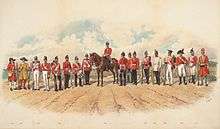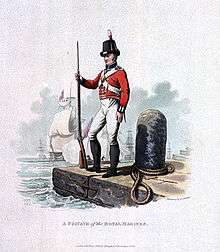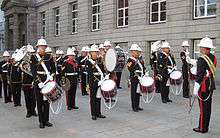Uniforms of the Royal Marines

The Royal Marines uniform is the standardised military dress worn by members of the Royal Marines.
Historic
Historically, Marine uniforms broadly matched those of the contemporary British Army, at least for full dress.[1] The constraints of shipboard duty however brought some practical considerations - for ordinary work duties during the late 18th and early 19th centuries the marines would put aside their easily stained red coats and wore the loose "slop" clothing of the British sailors (then known as Jack Tars). The full uniform was worn for watch and guard duties and would also normally be worn in action. It is recorded that at Trafalgar many marines fought in their undress checked shirts and blue trousers.[2]
The original British marines of the Duke of York and Albany's Maritime Regiment of Foot (1664–1689) wore yellow (probably yellow-brown) coats with red breeches and black felt hats.[3] Other short lived marine regiments during the period 1685 to 1699 wore dark blue, crimson or red coats.[4] Queen Anne's six Marine Regiments wore red coats with different coloured facings according to the preference of their individual colonels.[5] The dress of the ten Regiments of Marines raised for service between 1739 and 1748 is well documented in the coloured illustrations of the official 1742 Clothing Book. All wore red coats and breeches with mitre style caps. Facings, buttons and lace varied according to the regiment.[6]
From the establishment of a permanent corps of Marine Regiments in 1755 to 1802, red coats with white facings were worn.[7] The normal headdress was a tricorn (later bicorne hat and the overall appearance closely resembled that of the Army's Regiments of Foot. Grenadier companies were issued with fur hats, for land service only, during the American War of Independence. [8]


In 1802 the granting of the title "Royal Marines" meant a change to dark blue facings and a distinctive round hat made of lacquered felt.[9] This is the headdress usually associated with the marines of Nelson's navy. White breeches and gaiters were worn for parade during the Napoleonic Wars but blue or white trousers were normal shipboard wear. Short white jackets and bag-like undress caps were part of the sea-kit for ordinary duties, replacing the earlier casual or slop clothing that had often led to confusion between sailors and marines. The newly created Royal Marine Artillery wore the dark blue coat faced in red of the Royal Artillery with only buttons and badges as a distinction.[10]
The relatively peaceful period that followed the Napoleonic Wars saw the uniforms of the Royal Marines again closely follow Army styles. "Bell Top" Shakos and tight tail coats were adopted, regardless of their suitability for seagoing conditions. The Royal Marine Light Infantry continued to wear red coats with dark blue collars and cuffs.[11]
The Royal Marines wore dark blue serge jackets in the Anglo-Egyptian Campaign of 1882 with embroidered badges on their collars - bugle horns for the RMLI and grenades for the RMA. During the subsequent Sudan Campaign a light grey field uniform was adopted.[12] During the siege of the Peking Legations in 1900 the RMLI wore their usual hot weather ship-board working dress of blue field service cap, blue tunic and white trousers. Khaki or all white tropical uniforms were worn subsequent to the relief of the Legations.[13]
In 1905 a white cloth helmet with bronze fittings was adopted to be worn with the scarlet and blue full dress of the RMLI and the dark blue and red of the RMA. This headdress was replaced in 1912 by the white Wolseley pattern pith helmet, which remains the most distinctive feature of modern Royal Marine full dress.[14] The Royal Marine Brigade sent to Ostend in August 1914 wore dark blue undress uniforms but khaki service dress or khaki drill was worn for subsequent active service on land during World War I.[15]
During the Inter-War years the newly merged Royal Marines wore a full dress that combined features of both the RMLI and RMA uniforms worn until 1914. This comprised a Wolseley helmet, dark blue tunic and trousers with scarlet collars and trouser welts. Shoulder cords and slashed cuffs were in yellow.[16] This dress is still worn by the Royal Marines Band Service.

During World War II the Royal Marines wore khaki or blue battledress but retained their dark blue undress uniforms with red-banded peaked caps for certain off duty or ceremonial occasions.[17] The well known green beret was introduced for the Royal Marine Commandos in 1942.
Current uniforms
The modern Royal Marines retain a number of distinctive uniform items. These include the green beret, the green "Lovat" service dress, the dark blue parade dress worn with the white pith helmet or red & white peaked cap, the scarlet and blue mess dress for officers and non-commissioned officers[18] and the white hot-weather dress of the Band Service.[19]
See also
| Wikimedia Commons has media related to Royal Navy uniforms. |
References
- ↑ Barnes, p. 260
- ↑ Haythornthwaite, p. 48
- ↑ Stadden, p. 8
- ↑ Stadden, p. 12
- ↑ Stadden, p. 20
- ↑ Stadden, p. 24
- ↑ Stadden, p. 25-39
- ↑ Stadden, p. 28
- ↑ Stadden, p. 40
- ↑ Stadden, p. 44
- ↑ Stadden, p. 52
- ↑ Stadden, p. 68
- ↑ Stadden, p. 72
- ↑ Stadden, p. 76
- ↑ Stadden, p. 80
- ↑ Stadden, p. 88
- ↑ Stadden, p. 95
- ↑ Smith, p. 201-202
- ↑ Stadden, p. 120-125
Sources
- Barnes, R.M. (1972). Military Uniforms of Britain & the Empire. Sphere Books London. ISBN 978-0722114063.
- Haythornthwaite, Philip (1993). Nelson's Navy. Osprey. ISBN 1-85532-334-6.
- Smith, Peter C. (1988). The Royal Marines. A Pictorial History 1664-1987. Spellmount Publishers. ISBN 0-946771-32-4.
- Stadden, Charles C. (1997). Uniforms of the Royal Marines. The Pompadour Gallery. ISBN 0-9519342-2-8.